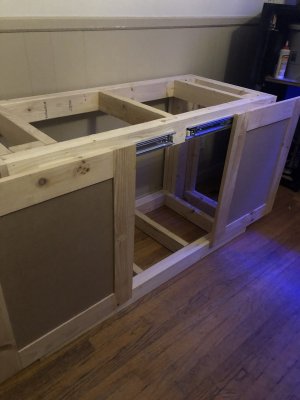Hey folks,
So I'm trying to guesstimate how much of my new build project (see below in sig line) I should try to tackle myself, and how much I should leave to the pros.
Reefer experience-wise, the most success I've had was with a 90-gallon AIO mixed reef (monti, birdsnest, xenia, acans, mushrooms, anemone) w/ easy to medium fish (hippo tang, clowns, hawk, flame angel). I managed to maintain that tank well and not kill anything for several years before having to sell everything and move for work.
So, I understand the basics of chemistry, flow, mechanical maintenance etc. I am not afraid to get my hands dirty and am fairly handy with basic home projects and tools. However, I'm not a builder, engineer, plumber, or electrician, and I'm hesitant to take on a large build of this scale and the $$$ investment involved by myself. On the other hand, I also don't necessarily want to just pay someone to come in and do everything for me. I'm the kind of person that wants to be hands on and understand the rationale behind why "this way" is better than "that way".
Luckily, I have found and developed a good rapport with a local LFS (The Coral Corral in case you're in the Tampa Bay and want to geek out with a pretty cool group of reef-nerds, thanks to @Gernader for the suggestion!), who I think will be a really good partner in this project.
So, in your experiences and opinion, which pieces of a build like this would be worth trying DIY, and which pieces would be better left to the pros at my experience level?
Those with the personal experiences on this scale are most welcome, but everyone please feel free to let me know your opinions!
Thank you!
So I'm trying to guesstimate how much of my new build project (see below in sig line) I should try to tackle myself, and how much I should leave to the pros.
Reefer experience-wise, the most success I've had was with a 90-gallon AIO mixed reef (monti, birdsnest, xenia, acans, mushrooms, anemone) w/ easy to medium fish (hippo tang, clowns, hawk, flame angel). I managed to maintain that tank well and not kill anything for several years before having to sell everything and move for work.
So, I understand the basics of chemistry, flow, mechanical maintenance etc. I am not afraid to get my hands dirty and am fairly handy with basic home projects and tools. However, I'm not a builder, engineer, plumber, or electrician, and I'm hesitant to take on a large build of this scale and the $$$ investment involved by myself. On the other hand, I also don't necessarily want to just pay someone to come in and do everything for me. I'm the kind of person that wants to be hands on and understand the rationale behind why "this way" is better than "that way".
Luckily, I have found and developed a good rapport with a local LFS (The Coral Corral in case you're in the Tampa Bay and want to geek out with a pretty cool group of reef-nerds, thanks to @Gernader for the suggestion!), who I think will be a really good partner in this project.
So, in your experiences and opinion, which pieces of a build like this would be worth trying DIY, and which pieces would be better left to the pros at my experience level?
Those with the personal experiences on this scale are most welcome, but everyone please feel free to let me know your opinions!
Thank you!



















